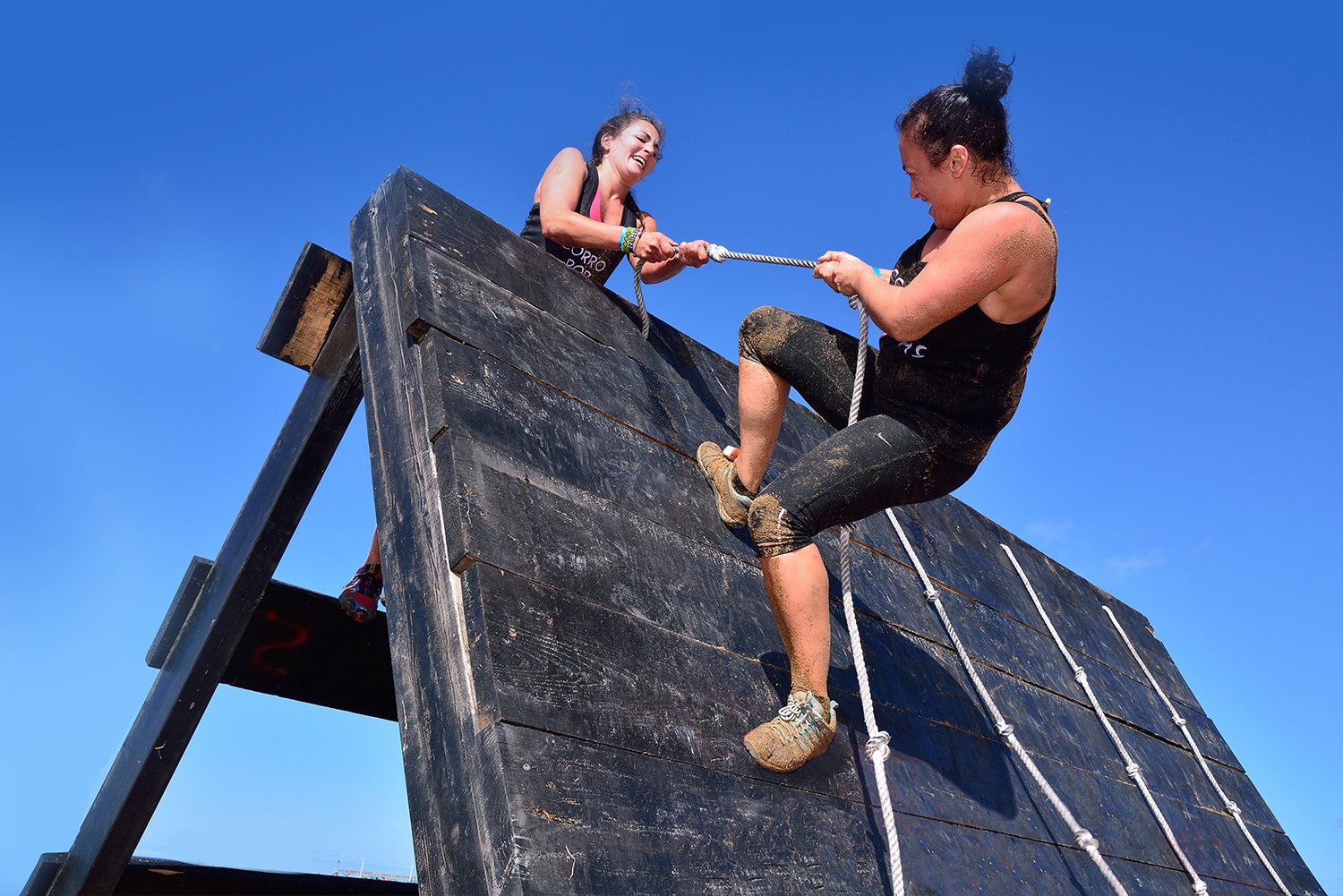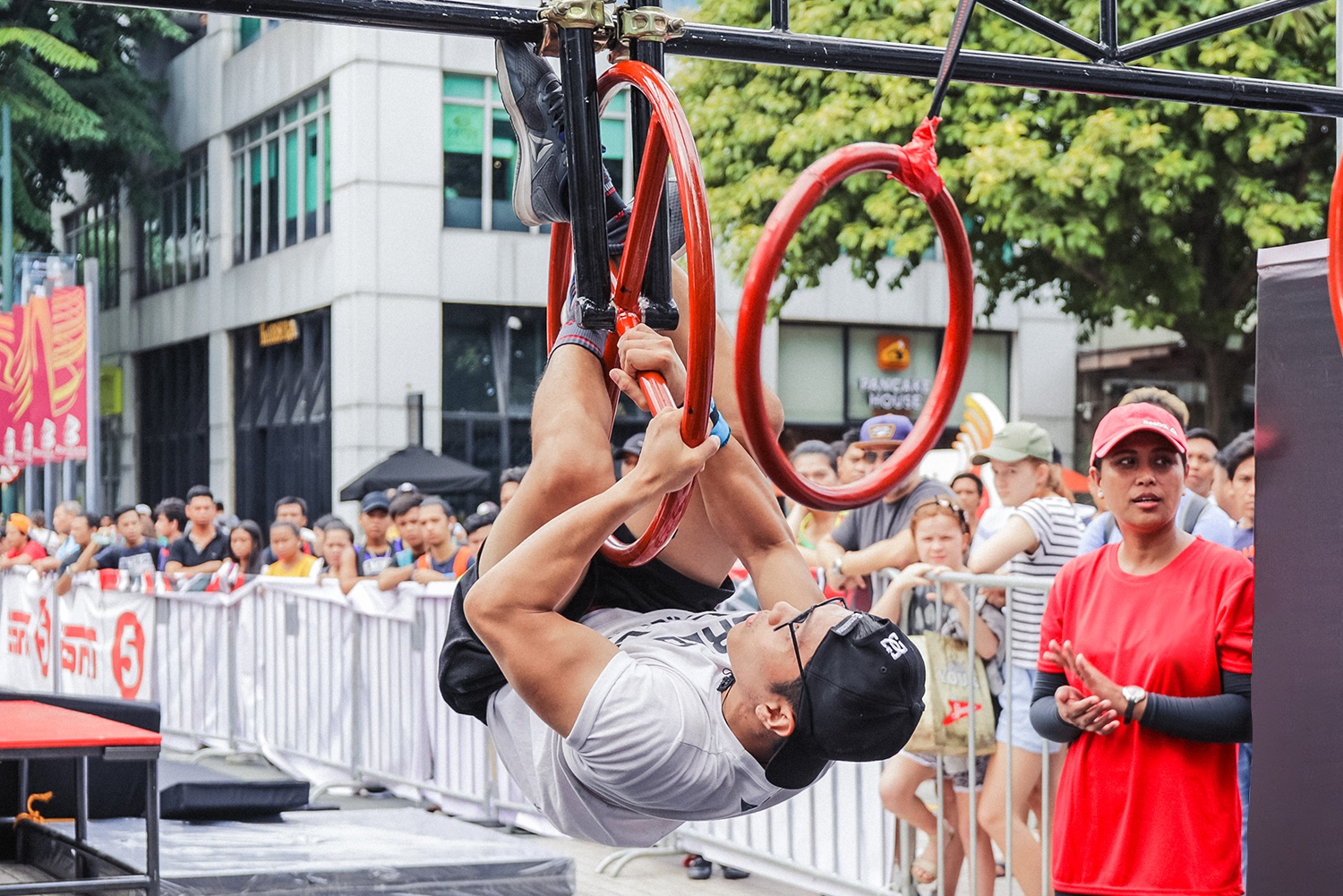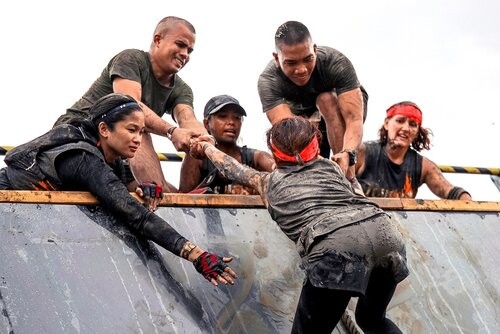Obstacle course racing is more than just training your endurance, strength, and speed. You also have to learn the techniques in passing the obstacles faster and using less of your energy. In this article, you’ll know the techniques in passing these 10 obstacles.
Barbed Wire Crawl, Monkey Bars, Inverted Wall, 6-Foot Wall, Everest, A-Frame, Cargo Net, Sandbag Carry, Multi Rig, Spear Throw, Rope Climb.

Strength and endurance training will get you a long way in obstacle course racing. You'll also benefit from knowing these techniques that seasoned OCR enthusiasts use to finish the course in the fastest, safest possible way.
Barbed Wire Crawl
Some racers think they’re being clever when they roll under the barbed wire to quickly get to the end of the obstacle. This is a mistake, and a potentially injurious one! Rolling can make you dizzy and disoriented. The most efficient way to get through Barbed Wire Crawl is to crawl fast.
However, don’t drag your body through the grass or mud. Keep your back straight because arching can get you cuts from the wire. You can improve your crawling speed by including bear crawls in your workout routine.
On race day, choose clothes that fit your body well to prevent it from getting caught on the wire. Trust us, you don’t want to be slowed down by any sports wear mishap.

Monkey Bars
Monkey bars require strong grips. To achieve this, practice hanging from a pull-up bar as long as possible. Do this at least once a day. You also need to train your body’s swinging momentum. In some races, the gaps between the bars widen as you move forward, so this may take some time to master. Once you hit the course, be mindful of the position of your shoulders and hands to keep your upper body muscles safe from strain, sprain, and soreness.
Inverted Wall

Vertical walls are a staple obstacle in OCR, so conquering them should be an element of your training plan. Walls differ in height and your height is also an important consideration in determining how best to blow by this impediment. Calculate and practice how many sprinting steps you need to scramble up the wall before a final extending leap enables you to grab over the top of the wall. From that point, lift your body hook one leg over the top. At this point, you’ve got it - you don’t our help anymore!
6-Foot Wall
Option 1
The first method is originally a parkour move called the "wall pass". Run to the wall and use one foot to push your body upwards and swing your arm to create momentum. Hold tight and pull yourself up. Once you reach the top, use your body weight to tip yourself over the wall.
Option 2
Grab the top of the wall as much as your reach allows. Hop up to get a better hold on it, then swing one leg up and hook it over the top of the wall. Have three points of contact on the surface of the top of the wall to maintain balance as you make your way over.
Whichever strategy you opt for, don't stretch your arms outward, because it will be harder to push your body up. Keeping your arms close to the side of your body is better form for getting past the 6-foot wall.
Everest
Standing at 13 feet and sometimes slippery with water or oil, Everest is an intimidating obstacle. As with all obstacles, success depends largely on technique and practice. To put this slippery beast in your rear-view mirror start from a distance and accelerate to a full sprint as you reach the base. Let your momentum carry you about ¾ of the way up before it really becomes vertical.
There’s a mental trick to it: Expert runners imagine the peak to be a foot higher than it actually is so they can push themselves more and not miss the mark.
A-Frame Cargo Net

Option 1
Cargo nets are historically useful for getting marine military troops off big ships and into amphibious landing crafts, so be secure in the knowledge that the technique and training that has helped soldiers carrying up to half their body weight in gear is well documented. Starting at the top of the cargo net, roll one of your legs over and securely place it onto a rung in the net, allowing you to reposition your hands for stability, then bring your other leg over. Depending on what's more comfortable for you, you can make your way down facing the net or with your back to it. Get over your fear of heights through training repetitions and put your focus where it needs to be - on your hands and the net itself as you make progress with sure and deliberate steps.
Option 2
If you're feeling confident, try the elite flip. Again, starting from the top of the cargo net, reach over and grab the vertical straps of the cargo net. Use them to roll your body into a somersault. It takes some mastery, but it's a quicker way to get down the cargo net.
To avoid muscle cramps while completing an obstacle course race, especially on the cargo net, keep yourself hydrated throughout your training and during the event. Avoid too much salty food and drink (including sports drinks) in the week leading up to race day.
Sandbag Carry
The sandbag carry is not the most challenging obstacle, but there is an efficient way to do it to preserve your energy and reduce the chance of injury. Carry a sandbag on your hip, over your shoulder, or on your back with your hands holding it – imagine like when you close the clasp of a necklace. If none of those positions feel quite right, you can always just hold the sandbag to your chest and hug it.
If the obstacle course racing event you're joining includes the sandbag carry, brace yourself for an uphill trek. Focus on your breathing and use your leg muscles to get to the top. Though much of your technique will have to do with your upper body, be conscious of the terrain in front of you to avoid tripping and ankle injuries.
Multi Rig

This obstacle requires endurance and a strong grip. Be smart about using your upper body strength and swinging momentum, because exhaustion is your biggest enemy on this obstacle. Look at the available lanes and choose the rigs that are closer together in distance and height.
If you can't find a practice rig, back-and-forth exercises on monkey bars at your local playground are an adequate substitute.
Spear Throw
The spear throw takes a lot of practice to get right, so don't be discouraged. Start with your hand grip and position: Find the middle of the spear so it's equally weighted in your hand. Allowing it to tilt forward or backward will mess up your throw. Use your thumb to support it from underneath.
Hold the spear right next to your head. Aim the tip of the spear straight at the bales of hay. Don't lob it like you would a basketball or football; instead, think of it as an oversized dart.
Rope Climb

The Rope Climb may seem like an easy obstacle: a single rope doesn’t present much intimidation, but don’t be fooled: unless you have upper body strength sufficient to classify you as a freak of nature, it is quite challenging and good technique is paramount.
Option 1: S - hook
Grip the rope in your hands and wrap your dominant leg around it. The rope should be behind your calf. Slide your foot under the rope and bend it forward. Now that the rope is wrapped around your dominant leg, step on your dominant foot using your free foot to lock the rope down. Hold your feet steady as you stretch your legs and walk your hands up the rope, then repeat the process.
Option 2: J - hook
An alternative to the S-hook is the J-hook. Start with the rope outside of your dominant foot. Hold on to the rope with your hands and lift your legs as high as you can. Use your other foot to sweep underneath your dominant foot, hooking the rope while you do so. This action forms the letter "J" in the rope. Lock the rope in place, and when you feel secure enough, straighten your legs and walk your hands up the rope. Repeat the whole thing until you reach the top.
Ready to be part of our Pretty Huge Family?
